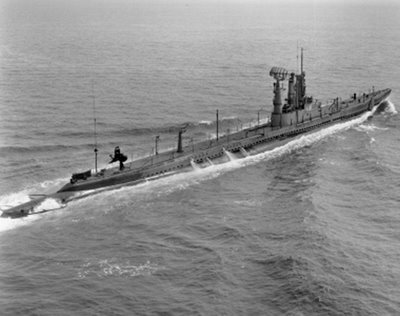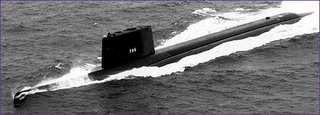
Scouts, whether relying on eyes and ears or electronic devices, have to get out front of that force for which they are scouting. As the use of air search and surface search radar spread during World War II, the job of protecting the fleet began to depend more and more on early detection of threats, the role of some ships became that of forming an "arc of electrons" in advance of the fleet, with each ship providing an overlapping semi-circle of radar coverage. If enemy forces intruded into the zone of coverage, the main body of the fleet was warned. As noted here, the units initially assigned to this mission were "radar picket destroyers" and their use was highlighted during the invasion of Okinawa:
The Invasion of Okinawa, only 350 miles from the Japanese mainland, brought about a new threat to the U S Navy: the Kamikaze Airplanes. They were conceived by the Japanese to stop the Invasion of Okinawa by destroying the invasion fleet and cut off supplies to the troops on shore.Which meant that the "radar pickets" paid a heavy price for being out front. An example of attacks on the radar pickets is found here in a description of an attack on the destroyers Drexler and Lowry. And more here concerning the destroyer Cassin Young:
These planes carried only enough fuel to reach the fleet protecting the invasion forces. They were flying bombs, guided by a fanatic pilot determined to crash his plane into a ship. He believed this would insure his immortality and prevent the humility of a Japanese defeat. They were determined to keep our fleet away from their homeland.
This did indeed give Admiral Halsey and other fleet commanders one of their greatest concerns. The 2100 ton Destroyers, were formed in a half circle to the north, about 40 to 70 miles out, to establish an early warning, Radar Picket line. They were deployed in four ship formations and could pick up incoming enemy Kamikazes up to 150 miles north of Okinawa. They became the pigeons, or the first ships of the fleet to be reached by the attacking Kamikazes; and often the fighter planes didn't arrive to intercept and shoot them down before they reached the Destroyers on the picket line.
April 1, 1945, was D-day at Okinawa. After escorting assault craft to the beaches and providing shoreShips lost to the kamikaze attacks included USS Pringle sunk with 69 hands lost (the map of the "picket stations" is from the Pringle site) and USS Little.bombardment, Cassin Young took up the duties of radar picket ship, possibly the most hazardous duty performed by any warship during World War II. The picket's role was to provide early warning of impending air attacks to the main fleet. The ships assigned to the fifteen picket stations bore the brunt of over fifteen hundred kamikaze attacks in the weeks and months ahead. Radar Picket (RP) Stations 1,2, and 3 faced the worst of these attacks. On April 6 the Japanese launched the first of ten massed attacks, sending 355 kamikazes and 341 bombers towards Okinawa. Cassin Young was on duty at RP Station 3. The ship downed three "bogeys" (enemy planes) and picked up survivors from the destroyers assigned to RP Stations 1 and 2 (both were hit and sunk by kamikazes).
Cassin Young was then assigned to RP Station 1 where, on April 12, the ship came under massive attack. Six kamikazes were shot down, but one hit the mast and exploded fifty feet above the ship. One sailor was killed and 59 were wounded. After repairs, Cassin Young returned to Okinawa in July for further duty. Only individual kamikaze attacks were now occurring as the Japanese hoarded 10,000 aircraft to throw against the U.S. fleet in the upcoming invasion of Japan.
Cassin Young's most severe test came just sixteen days before Japan surrendered. At 3:26 a.m. on July 30, a single kamikaze crashed the starboard side of the main deck near the forward smoke stack. There was a tremendous explosion amidships and the ship lay dead in the water. The crew contained the damage, restored power in one engine and got the ship underway within twenty minutes. Casualties were 22 men dead and 45 wounded. Cassin Young was the last ship hit by kamikazes in the vicinity of Okinawa.
As the risks of using destroyers as radar pickets became evident, the Navy, anticipating that the situation would worsen should Japan itself become the target, thought up some alternatives, including the use of submarines as radar pickets, as set out in


Cold War Curiosities. U.S. Radar Picket Submarines:
In the closing months of the Pacific war, Japan's desperate use of kamikaze aircraft - suicide planes - in its last-ditch defense of the home islands inflicted serious damage on the gathering Allied fleet. In attempting to counter this new threat during the invasion of Okinawa in April 1945, the U.S. Navy deployed lines of destroyers as "radar pickets" across the threat axis at some distance from their task group centers. Although these distant ships provided timely early warning of Japanese air attacks and significantly reduced the toll taken of major combatants, they themselves proved exceptionally vulnerable to kamikaze tactics, and twelve were sunk.Get the idea? You take a submarine. You put it way out in front of the fleet and make it sit on the surface to detect enemy air raids. When the enemy is too close for comfort and safety, the submarine seeks the safety of deep water.
Since the anticipated invasion of Japan itself - scheduled for November 1945 - was expected to attract an even more intense kamikaze onslaught, the Navy high command sought to use submarines as less vulnerable radar pickets and in July 1945 ordered that 24 boats be prepared for that role by installing an approximation of a typical destroyer's radar and air-control capabilities. Since preliminary tests indicated that the standard submarine radar could not detect air targets above 10,000 feet or beyond 27,000 yards, and because there would need to be a combat information center (CIC) and appropriate communications onboard for controlling interceptors, the necessary full-blown conversions would have stretched into 1946, too late for their intended role in the invasion of Japan. As an interim measure, COMSUBPAC modified the SV air-search radars on USS Grouper (SS-214) and USS Finback (SS-230) for periscope mounting and operation at shallow submergence, and similar conversions of four other boats - including rudimentary CICs - had already begun when the Japanese surrendered in August 1945.
Even though WWII ended, the idea of using of submarines as radar pickets was not immediately abandoned. As reported here there was a lot of experimenting going on:
Faced with an abundance of new and relatively new submarines, the Navy experimented with hastily-converted surface ship radar equipment aboard submarines. REQUIN, after nearly a year in commission, and SPINAX (SS 489), while still on the ways at Portsmouth, became the first radar picket submarines in the US Navy. Envisioned to carry radar capable of controlling friendly aircraft defending against attacking enemy aircraft, directing outbound aircraft, it was envisioned that these radar picket submarines could also provide an early warning capability to the surface fleet.And these boats were worked hard:
Faced with problems that would last throughout the life of the radar picket program, REQUIN would encounter overcrowding problems (she retained all ten torpedo tubes until her MIGRAINE conversion) and flooding (the radar mounted on her stern would short out quite frequently), REQUIN was subjected to another more extensive conversion as a radar picket under the somewhat appropriately named MIGRAINE Program. Designated as SSR-481in January of 1948, REQUIN would lose her four stern torpedo tubes, with the space gained in the forward part of the stern room being converted into a full-blown air control center (REQUIN vets who served aboard during the radar picket days would refer to this as the combat information center). The remaining space, where the tubes themselves once were, was converted into berthing space for the extra crew. In addition, REQUIN lost the use of the two bottom tubes in the forward torpedo room, which were converted into storage lockers. Topside, the 40 mm cannon on the aft cigarette deck was removed, with the space being taken up by an SR-2 air search radar. In addition, REQUIN received a YE-3 fighter controller beacon, located above the after engine room on deck, as well as an SV-2 low angle surface search radar. (This radar, because it was located so close to the water line near the screws, often shorted out and was commonly referred to as the "Nodding Idiot".) Finally, REQUIN also received a snorkel, which allowed her to run her four Fairbanks-Morse engines while submerged at periscope depth.
Life for REQUIN as a radar picket was tough duty. Many of the normal fleet boats still in service stayed out for two to three months. REQUIN, because of her unique status as a radar picket..., would often stay out much longer, just coming into port to refuel and reprovision.And the program sort of "faded away" -
Finally, with the advent of airborne early warning aircraft, such as the P2V Neptune and E-2 Hawkeye, the Navy decided to end the radar picket program in the late 1950s.

Before it died, at least one nuclear submarine was designed for the radar picket program, USS Triton:
Triton was designed in the mid-1950s as a radar picket submarine able to operate at high speed, on the surface, ahead of a task force, providing intelligence information, electronic surveillance, and to control fighter aircraft interception. Triton would then submerge to avoid attack and operate as a fully operational submarine. To achieve this high speed, Triton was designed with two reactor propulsion plants (the only United States nuclear submarine ever to have been thus built), a knife-like bow, and a high reserve buoyancy. She was the last submarine to have a conning tower (a water-tight compartment built into the sail). She was also the last American submarine to have twin screws or a stern torpedo room.More:
USS TRITON ( SSN 586) was designed to be fast enough to operate with a fast carrier task force. One of the largest submarines ever built, Triton is 447 feet long, displaces more than 7700 tons submerged, and carries a crew of approximately 170. Her keel was hid 29 May 1956, she was launched 19 Aug. 1958, and was commissioned 10 Nov. 1959. She has two pressurized water reactors, one for each of her two propellers.Triton was also the first submarine to complete a submerged circumnavigation of the Earth.
Although like the most recent SSRs, Triton mounted her air-search radar on the sail where it could be stowed within the fairwater for submergence, her newer AN/SPS-26 was scanned electronically in elevation, so no separate height-finding radar was required. With three deck levels beneath the sail, there was ample room for dedicated air-control facilities just below the control room/attack center.
Give a salute to the men of the radar pickets who served so well!

Where is acknowledgement of USS Pompon, SSR 267? Re-commissioned around 1953 and de-commissioned 1959.
ReplyDeleteI think you just made it.
ReplyDeleteSee here